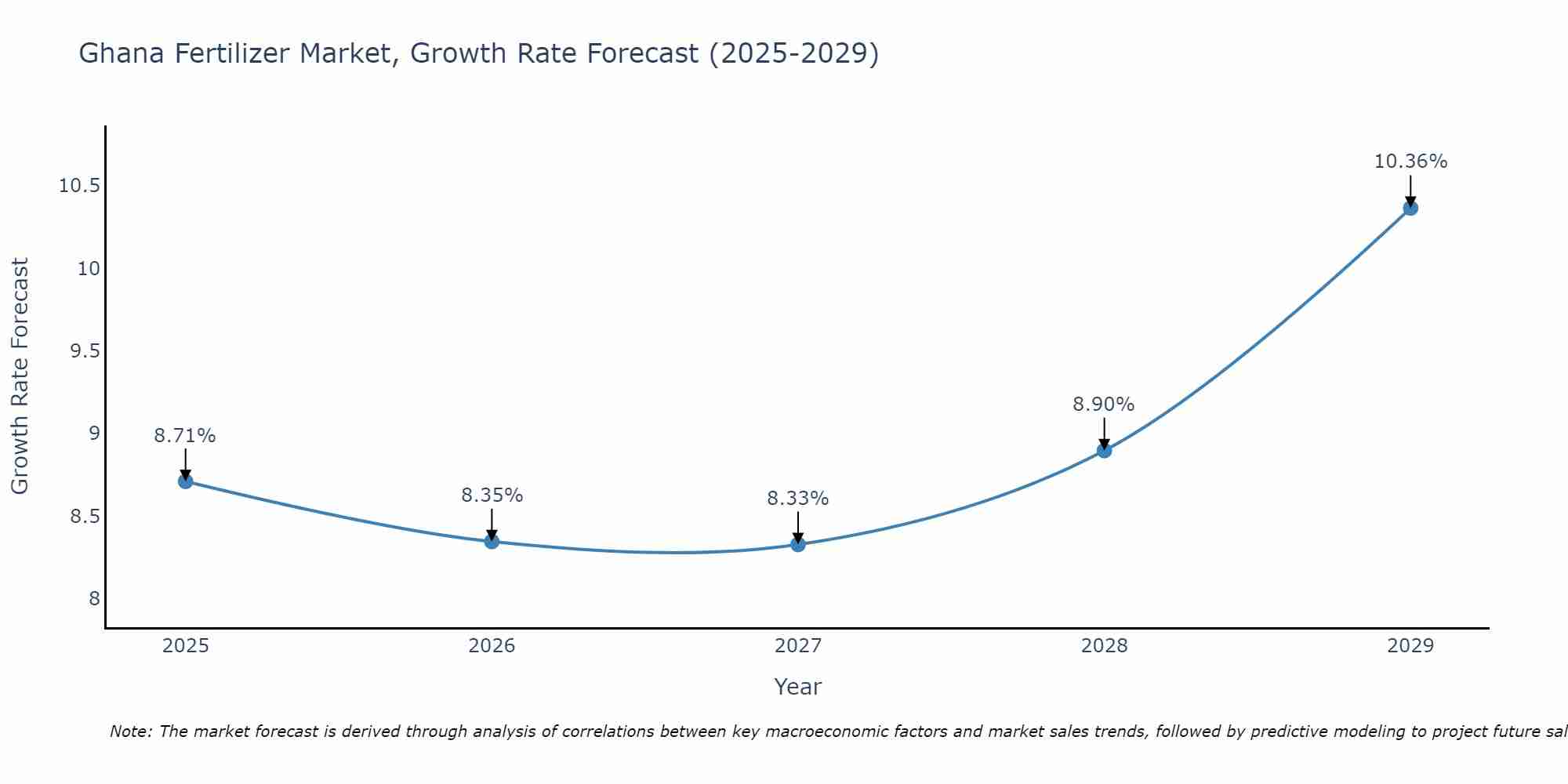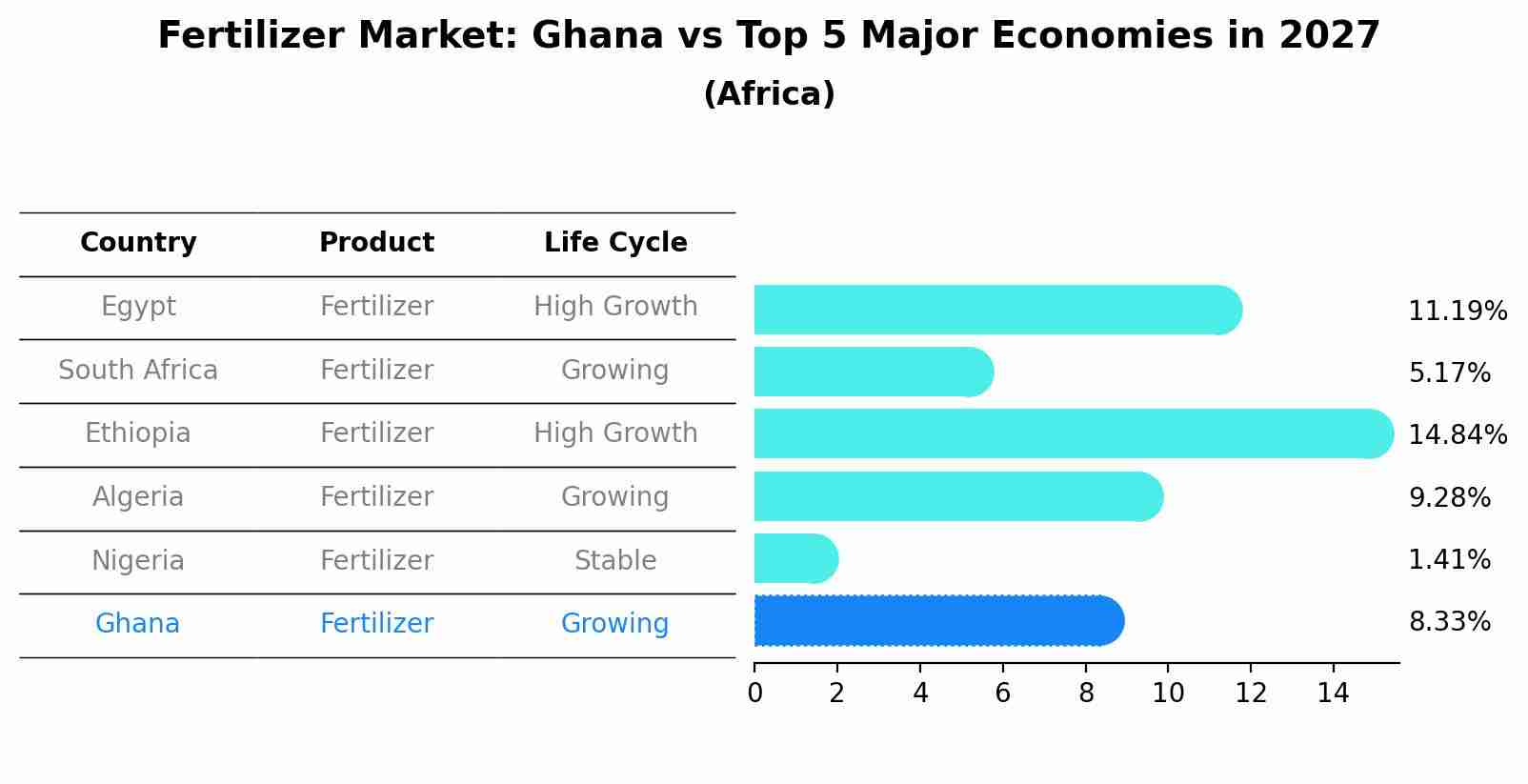Ghana Fertilizer Market (2025-2031) | Trends, Share, Value, Forecast, Growth, Industry, Revenue, Size, Companies, Analysis & Outlook
| Product Code: ETC043236 | Publication Date: Jan 2021 | Updated Date: Jun 2025 | Product Type: Report | |
| Publisher: 6Wresearch | Author: Sumit Sagar | No. of Pages: 70 | No. of Figures: 35 | No. of Tables: 5 |
Ghana Fertilizer Market Size Growth Rate
The Ghana Fertilizer Market is projected to witness mixed growth rate patterns during 2025 to 2029. The growth rate starts at 8.71% in 2025 and reaches 10.36% by 2029.

Fertilizer Market: Ghana vs Top 5 Major Economies in 2027 (Africa)
By 2027, Ghana's Fertilizer market is forecasted to achieve a growing growth rate of 8.33%, with Egypt leading the Africa region, followed by South Africa, Ethiopia, Algeria and Nigeria.

Ghana Fertilizer Market Overview
The Ghana fertilizer market is currently experiencing growth driven by increasing adoption of fertilizers to improve crop yields and address soil nutrient deficiencies. The market is characterized by a mix of local and international fertilizer companies offering a range of products including nitrogen, phosphorus, and potassium-based fertilizers. Key players in the market include Yara Ghana, Wienco Ghana, and Chemico Ltd. The government of Ghana has also implemented various initiatives to promote the use of fertilizers among smallholder farmers, further boosting market demand. Challenges in the market include affordability issues for small-scale farmers, distribution inefficiencies, and the need for more tailored fertilizer solutions to suit different soil types and crops. Overall, the Ghana fertilizer market shows promise for continued growth and innovation in the coming years.
Ghana Fertilizer Market Trends
The Ghana fertilizer market is experiencing a shift towards organic and environmentally friendly products, driven by a growing awareness of sustainable farming practices. Farmers are increasingly seeking out organic and bio-based fertilizers to improve soil health and reduce chemical inputs. Additionally, there is a rising demand for customized fertilizer blends tailored to specific crop and soil requirements. The government`s initiatives to promote balanced fertilization practices and increase access to fertilizers for smallholder farmers are also influencing market trends. Overall, there is a movement towards more sustainable and efficient fertilizer use in Ghana, with a focus on maximizing crop yields while minimizing environmental impact.
Ghana Fertilizer Market Challenges
In the Ghana fertilizer market, some of the key challenges include limited access to credit for farmers to purchase fertilizers, inconsistent government policies affecting the importation and distribution of fertilizers, inadequate infrastructure for storage and transportation of fertilizers to rural areas, and the presence of counterfeit or substandard fertilizers in the market. Additionally, there is a lack of awareness among farmers about the correct usage and benefits of fertilizers, leading to suboptimal application practices. These challenges contribute to lower agricultural productivity and hinder the growth of the fertilizer market in Ghana. Addressing these issues would require collaboration between government agencies, private sector stakeholders, and farmers to improve access to quality fertilizers, provide education and training on best practices, and invest in infrastructure development.
Ghana Fertilizer Market Investment Opportunities
The Ghana fertilizer market presents promising investment opportunities due to the country`s agriculture sector being a significant contributor to its economy. With a growing population and increasing food demand, there is a rising need for fertilizers to improve crop yields and enhance agricultural productivity. Investors can explore opportunities in manufacturing and distributing various types of fertilizers tailored to the specific needs of Ghanaian crops. Additionally, investing in research and development of innovative and sustainable fertilizer solutions can help meet the evolving demands of the market. Collaborating with local farmers and agricultural organizations to provide education and training on proper fertilizer usage can also be a lucrative investment avenue in Ghana`s fertilizer market.
Ghana Fertilizer Market Government Policy
The Ghanaian government has implemented various policies to support the fertilizer market in the country. These policies include the establishment of the Planting for Food and Jobs program, which aims to increase fertilizer usage among smallholder farmers through subsidies and incentives. Additionally, the government has put in place regulations to ensure the quality and efficacy of fertilizers being sold in the market. Furthermore, initiatives such as the establishment of the Ghana Fertilizer Regulatory Authority and the National Fertilizer Monitoring Committee have been introduced to oversee the sector and promote transparency. Overall, these policies are geared towards improving agricultural productivity, enhancing food security, and boosting the competitiveness of the fertilizer market in Ghana.
Ghana Fertilizer Market Future Outlook
The future outlook for the Ghana fertilizer market appears promising due to several factors. The increasing adoption of modern agricultural practices, government initiatives to promote fertilizer use, and rising demand for food security are expected to drive market growth. Additionally, the growing awareness among farmers about the benefits of fertilizers in enhancing crop yields and overall agricultural productivity will further boost the market. The entry of new players, technological advancements in fertilizer production, and the focus on sustainable agriculture practices are also likely to contribute to the market`s expansion. However, challenges such as access to finance for farmers, distribution issues, and fluctuating fertilizer prices may pose some hurdles to market growth. Overall, the Ghana fertilizer market is anticipated to witness steady growth in the coming years.
Key Highlights of the Report:
- Ghana Fertilizer Market Outlook
- Market Size of Ghana Fertilizer Market, 2024
- Forecast of Ghana Fertilizer Market, 2026
- Historical Data and Forecast of Ghana Fertilizer Revenues & Volume for the Period 2021 - 2031
- Ghana Fertilizer Market Trend Evolution
- Ghana Fertilizer Market Drivers and Challenges
- Ghana Fertilizer Price Trends
- Ghana Fertilizer Porter's Five Forces
- Ghana Fertilizer Industry Life Cycle
- Historical Data and Forecast of Ghana Fertilizer Market Revenues & Volume By Type for the Period 2021 - 2031
- Historical Data and Forecast of Ghana Fertilizer Market Revenues & Volume By Straight Fertilizers for the Period 2021 - 2031
- Historical Data and Forecast of Ghana Fertilizer Market Revenues & Volume By Complex Fertilizers for the Period 2021 - 2031
- Historical Data and Forecast of Ghana Fertilizer Market Revenues & Volume By Crop Type for the Period 2021 - 2031
- Historical Data and Forecast of Ghana Fertilizer Market Revenues & Volume By Grains and Cereals for the Period 2021 - 2031
- Historical Data and Forecast of Ghana Fertilizer Market Revenues & Volume By Pulses and Oilseeds for the Period 2021 - 2031
- Historical Data and Forecast of Ghana Fertilizer Market Revenues & Volume By Commercial Crops for the Period 2021 - 2031
- Historical Data and Forecast of Ghana Fertilizer Market Revenues & Volume By Fruits and Vegetables for the Period 2021 - 2031
- Historical Data and Forecast of Ghana Fertilizer Market Revenues & Volume By Other for the Period 2021 - 2031
- Ghana Fertilizer Import Export Trade Statistics
- Market Opportunity Assessment By Type
- Market Opportunity Assessment By Crop Type
- Ghana Fertilizer Top Companies Market Share
- Ghana Fertilizer Competitive Benchmarking By Technical and Operational Parameters
- Ghana Fertilizer Company Profiles
- Ghana Fertilizer Key Strategic Recommendations
Frequently Asked Questions About the Market Study (FAQs):
1 Executive Summary |
2 Introduction |
2.1 Key Highlights of the Report |
2.2 Report Description |
2.3 Market Scope & Segmentation |
2.4 Research Methodology |
2.5 Assumptions |
3 Ghana Fertilizer Market Overview |
3.1 Ghana Country Macro Economic Indicators |
3.2 Ghana Fertilizer Market Revenues & Volume, 2019 & 2026F |
3.3 Ghana Fertilizer Market - Industry Life Cycle |
3.4 Ghana Fertilizer Market - Porter's Five Forces |
3.5 Ghana Fertilizer Market Revenues & Volume Share, By Type, 2021 & 2031F |
3.6 Ghana Fertilizer Market Revenues & Volume Share, By Crop Type, 2019 & 2026F |
4 Ghana Fertilizer Market Dynamics |
4.1 Impact Analysis |
4.2 Market Drivers |
4.3 Market Restraints |
5 Ghana Fertilizer Market Trends |
6 Ghana Fertilizer Market, By Types |
6.1 Ghana Fertilizer Market, By Type |
6.1.1 Overview and Analysis |
6.1.2 Ghana Fertilizer Market Revenues & Volume, By Type, 2016 - 2026F |
6.1.3 Ghana Fertilizer Market Revenues & Volume, By Straight Fertilizers, 2016 - 2026F |
6.1.4 Ghana Fertilizer Market Revenues & Volume, By Complex Fertilizers, 2016 - 2026F |
6.2 Ghana Fertilizer Market, By Crop Type |
6.2.1 Overview and Analysis |
6.2.2 Ghana Fertilizer Market Revenues & Volume, By Grains and Cereals, 2016 - 2026F |
6.2.3 Ghana Fertilizer Market Revenues & Volume, By Pulses and Oilseeds, 2016 - 2026F |
6.2.4 Ghana Fertilizer Market Revenues & Volume, By Commercial Crops, 2016 - 2026F |
6.2.5 Ghana Fertilizer Market Revenues & Volume, By Fruits and Vegetables, 2016 - 2026F |
6.2.6 Ghana Fertilizer Market Revenues & Volume, By Other, 2016 - 2026F |
7 Ghana Fertilizer Market Import-Export Trade Statistics |
7.1 Ghana Fertilizer Market Export to Major Countries |
7.2 Ghana Fertilizer Market Imports from Major Countries |
8 Ghana Fertilizer Market Key Performance Indicators |
9 Ghana Fertilizer Market - Opportunity Assessment |
9.1 Ghana Fertilizer Market Opportunity Assessment, By Type, 2019 & 2026F |
9.2 Ghana Fertilizer Market Opportunity Assessment, By Crop Type, 2019 & 2026F |
10 Ghana Fertilizer Market - Competitive Landscape |
10.1 Ghana Fertilizer Market Revenue Share, By Companies, 2024 |
10.2 Ghana Fertilizer Market Competitive Benchmarking, By Operating and Technical Parameters |
11 Company Profiles |
12 Recommendations |
13 Disclaimer |
- Single User License$ 1,995
- Department License$ 2,400
- Site License$ 3,120
- Global License$ 3,795
Search
Thought Leadership and Analyst Meet
Our Clients
Related Reports
- Afghanistan Rocking Chairs And Adirondack Chairs Market (2026-2032) | Size & Revenue, Competitive Landscape, Share, Segmentation, Industry, Value, Outlook, Analysis, Trends, Growth, Forecast, Companies
- Afghanistan Apparel Market (2026-2032) | Growth, Outlook, Industry, Segmentation, Forecast, Size, Companies, Trends, Value, Share, Analysis & Revenue
- Canada Oil and Gas Market (2026-2032) | Share, Segmentation, Value, Industry, Trends, Forecast, Analysis, Size & Revenue, Growth, Competitive Landscape, Outlook, Companies
- Germany Breakfast Food Market (2026-2032) | Industry, Share, Growth, Size, Companies, Value, Analysis, Revenue, Trends, Forecast & Outlook
- Australia Briquette Market (2025-2031) | Growth, Size, Revenue, Forecast, Analysis, Trends, Value, Share, Industry & Companies
- Vietnam System Integrator Market (2025-2031) | Size, Companies, Analysis, Industry, Value, Forecast, Growth, Trends, Revenue & Share
- ASEAN and Thailand Brain Health Supplements Market (2025-2031) | Strategy, Consumer Insights, Analysis, Investment Trends, Opportunities, Growth, Size, Share, Industry, Revenue, Segments, Value, Segmentation, Supply, Forecast, Restraints, Outlook, Competition, Drivers, Trends, Demand, Pricing Analysis, Competitive, Strategic Insights, Companies, Challenges
- ASEAN Bearings Market (2025-2031) | Strategy, Consumer Insights, Analysis, Investment Trends, Opportunities, Growth, Size, Share, Industry, Revenue, Segments, Value, Segmentation, Supply, Forecast, Restraints, Outlook, Competition, Drivers, Trends, Demand, Pricing Analysis, Competitive, Strategic Insights, Companies, Challenges
- Europe Flooring Market (2025-2031) | Outlook, Share, Industry, Trends, Forecast, Companies, Revenue, Size, Analysis, Growth & Value
- Saudi Arabia Manlift Market (2025-2031) | Outlook, Size, Growth, Trends, Companies, Industry, Revenue, Value, Share, Forecast & Analysis
Industry Events and Analyst Meet
Whitepaper
- Middle East & Africa Commercial Security Market Click here to view more.
- Middle East & Africa Fire Safety Systems & Equipment Market Click here to view more.
- GCC Drone Market Click here to view more.
- Middle East Lighting Fixture Market Click here to view more.
- GCC Physical & Perimeter Security Market Click here to view more.
6WResearch In News
- Doha a strategic location for EV manufacturing hub: IPA Qatar
- Demand for luxury TVs surging in the GCC, says Samsung
- Empowering Growth: The Thriving Journey of Bangladesh’s Cable Industry
- Demand for luxury TVs surging in the GCC, says Samsung
- Video call with a traditional healer? Once unthinkable, it’s now common in South Africa
- Intelligent Buildings To Smooth GCC’s Path To Net Zero


















